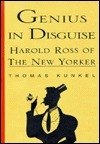What do you think?
Rate this book


497 pages, Hardcover
First published March 7, 1995
More than anyone else on staff, Ross had an uncanny sense of what enlisted men would and wouldn’t read. It was the commoner’s touch, which sprang from his own background as well as his multifarious professional experience. He himself recognized this singular capability and asserted it from the beginning.The section concludes with Ross returning to New York after the war, “the most widely known private in the American Expeditionary Forces”, and “New Yorker”, a chapter about Ross’s first marriage, and the years 1923 and 1924 in which he hatched the idea for his new magazine, found funding for it, and in the fall of 1924 produced the prospectus for the magazine, reproduced in an Appendix, and called by Kunkel “the most famous magazine prospectus in history”.

”Hiroshima” was a sensation. The issue sold out almost immediately, copies being scalped for fifteen and twenty dollars. Broadcasters read from it over the radio. Demand to reprint it came in from newspapers and syndicates around the world (proceeds were donated to Red Cross relief). An instant book was made and snapped up by the Book-of-the-Month Club … Albert Einstein asked for one thousand copies of the issue.
